

WS2812B - This should be a regulated supply voltage between 3.3V and about 5V.

More than that could harm the LED, less than 5V will either reduce brightness, or it just won't turn on.

Try checking out the Lumenati Hookup Guide that uses the APA102-based LEDs for more information. The FastLED library does support the WS2812 chipset. The APA102 requires the FastLED library to control. The APA102 LEDs are very similar to WS2812s with a few caveats: APA102s can be controlled with a standard SPI interface, and they have an extremely high PWM frequency. Note: Make sure to not confuse the WS2812-based IC with the APA102 addressable LEDs. Our go-to is the classic Arduino Uno, but any Arduino board should do. Something that can send the series of 1's and 0's used to control the LEDs. MicrocontrollerĪside from the star of the show, you'll also need a microcontroller. Grab however many you think you'll need for your project, regardless of how many you have, it's not enough. The more the merrier! In the example hookup, we'll be linking together five breakout boards, but the example should be adaptable to the other WS2812-based products. Stating the obvious: you'll need a WS2812-based board or strip. Required Materials WS2812-Based LED Board or Strip And we'll close the tutorial out with some example Arduino code. We'll go over some of the ways you might want to hook up to the breakout board, LilyPad, or strips. In this tutorial we're going to get you familiar with the workings of the WS2812 and WS2812B. The more boards you have linked together, the fancier your animations can be! Plus they're chain-able - the output of one LED can be connected to the input of another to create strips of hundreds of LEDs. With the help of some libraries, they're really very easy to control. The IC embedded into the LED communicates via a very unique one-wire interface. What makes the WS2812B really special is the way its controlled.


 0 kommentar(er)
0 kommentar(er)
